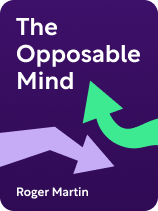

This article is an excerpt from the Shortform book guide to "The Opposable Mind" by Roger Martin. Shortform has the world's best summaries and analyses of books you should be reading.
Like this article? Sign up for a free trial here.
What makes some leaders consistently better at solving complex problems? How do innovative thinkers approach difficult decisions differently from everyone else?
In The Opposable Mind, Roger L. Martin breaks down the components of decision-making in the context of integrative thinking. His approach helps leaders move beyond conventional solutions to find creative breakthroughs that combine the best aspects of competing options.
Read more to learn how to develop these powerful thinking skills and put them to work in your own decision-making process.
The 3 Components of Decision-Making
In his book, Martin elucidates the patterns of thinking that innovative leaders use (integrative thinking), and then he turns to how to put those skills into practice. Martin divides decision-making into three components—determining what information is important, exploring the ways that different factors relate to each other, and then merging the best aspects of different possible solutions. All the while, integrative thinkers acknowledge their perspectives’ limitations and the complexity of the problems they face. Let’s explore these three components of decision-making.
Component 1: Gathering Important Information From All Sides
When faced with complex problems, necessity requires that we ignore most of the data and focus on whichever elements seem most pertinent. This selective attention shapes how we frame situations, but Martin says you must still gather data from multiple points of view. Different people arrive at different conclusions based on their particular sets of mental filters. These filters don’t just guide your judgments, but also what information you choose to ignore. For instance, sports fans often disagree on penalty calls because they disregard information that doesn’t support their preferred outcome. Therefore, when making important decisions, you have to recognize your bias and actively look for ways to negate it.
(Shortform note: This part of Martin’s advice can be hard to follow because everyone’s biases, including your own, are ingrained from an early age. In Biased, Jennifer Eberhardt explains that in assessing bias, you can’t just look at the information being presented; you also have to pay attention to what’s left unsaid. Additionally, you should beware of supposedly “impartial” information sources that may be biased if they stand to benefit from convincing you of their claims. In Designing the Mind, Ryan A. Bush offers a program to overcome your personal biases involving mindfulness practices, lots of study, and personal reflection, all of which help to clear your mental path to mastering Martin’s integrative thinking.)
If you can see beyond your flawed perspective, Martin writes that you can hold multiple points of view at once and explore the gap between opposing ideas, leading to more innovative solutions. This may be harder than it sounds because your brain automatically defaults to the assumption that your interpretation of reality is correct, limiting your ability to consider alternate perspectives. The trick is to know the difference between reality and your mind’s filtered perception. Martin argues that the most successful leaders do this—they can, in effect, “step outside” of a problem and evaluate it from every angle at once.
(Shortform note: In Thinking, Fast and Slow, psychologist Daniel Kahneman explores the nuances of the brain’s automatic “System 1” mode of thinking, which is fast but limited by assumptions and bias, and its slower “System 2” contemplation, which is less prone to errors and illusions. Martin’s advice for leaders implies that you can learn to engage System 2 thinking to override your automatic mind, but Kahneman points out that System 2 has a limited capacity for focused thought and is easily overloaded. Practice and experience can ease the load on System 2, but Kahneman recommends that you aim for a compromise and let your mind run in automatic System 1 when the cost of potential errors is low.)
Component 2: Looking at the Whole, Not Just the Pieces
The next thing Martin says that creative leaders do is embrace the inherent complexity of situations, resisting the urge to simplify problems to make them “easier to handle.” Simplifying issues leads to rote, half-baked solutions that aren’t likely to produce significant breakthroughs. Innovative thinkers, on the other hand, consider the wide range of cause and effect when they generate new ideas. For example, a restaurateur expanding their business to a new city may look beyond the common factors of location, marketing, and pricing to explore the region’s food culture, how people react to new businesses moving in, any seasonal habits that might affect people’s dining, and how shifting demographics might be changing the new city’s character.
(Shortform note: One danger in Martin’s suggestion to embrace complexity is that in some intractable problems, complexity can become a rabbit hole that you’ll never see the end of. Therefore, in Algorithms to Live By, Brian Christian and Tom Griffiths argue that the best way to solve such problems is to strategically embrace imperfection as well. For instance, in the technology sector, when computers deal with extremely complex problems, they might calculate an answer half as good as the perfect solution in one quadrillionth of the time. Likewise, when solving problems in business, we can often achieve “good enough” successes more quickly and efficiently than we can reach some perfect ideal. Acknowledging complexity as Martin recommends may often mean looking for answers that are merely workable and moving on.)
One form of simplification that hinders creative thinking is specialization, which often gives someone a narrow focus that ignores the bigger picture. The solution Martin offers is to assemble a diverse team with complementary skills and perspectives to draw from. As a leader, then, you can keep the big picture of a project in mind while fostering constant interaction among team members with a variety of backgrounds. Collaboration helps prevent the tunnel vision that results from specialization, enabling you to find creative answers to business problems. Martin adds that your goal shouldn’t be to make everyone a generalist, but to combine specialists’ knowledge in ways that lead to innovative outcomes.
(Shortform note: Martin’s response to overspecialization goes against the grain of long-standing corporate decisions to hire candidates who fit their companies’ culture, a practice that’s frequently criticized as a slippery slope toward discrimination. However, in Leading Change, John P. Kotter writes that while changing a company’s culture is necessary to keep up with the times, he still argues in favor of hiring based on cultural fit, suggesting that cultural change must be approached slowly. In Delivering Happiness, Tony Hsieh suggests that instead of hiring for cultural fit, you should look for candidates who will actively improve the company’s culture. Doing so can bring a diversity of values in addition to the diversity of skills Martin touts.)
Component 3: Rejecting the “Either/Or” Option
Martin says that, once innovative leaders have assembled all the different points of view that suggest a variety of potential ways to move forward, they seek solutions that embody the best of every option instead of deciding between them. For instance, the hypothetical restaurateur mentioned earlier might be deciding between opening a high-class eatery or an affordable family restaurant. Instead of choosing one option only, they might decide to merge the best aspects of both and devise a way to provide families with a high-end dining experience they can afford. Martin argues that the business world’s most successful breakthroughs come when leaders turn their backs on conventional options.
(Shortform note: It may seem as if Martin is promoting compromise as a way to solve problems, but this aspect of the integrative approach is more in line with systems thinking, which looks at connections between different factors that influence your decisions and finds synergies that may not be apparent when considering issues in isolation. In The Fifth Discipline, Peter Senge explains that to effectively solve business problems, you have to see your organization and the world it interacts with as one big system. When you recognize how one course of action affects every part of the system—such as how the restaurant in the example above interacts with a variety of customers in different ways—you can find the innovative solutions Martin speaks of.)
As opposed to conventional thinking, which tends to simplify problems, weed out tangential variables, and accept “good enough” solutions, Martin asserts that innovative thinking produces new possibilities and reveals the world’s limitless potential. Over time, this type of thinking can raise your aspirations—once you step away from the quick and easy path, you might discover how much more you can actually achieve. Martin writes that creative leaders and thinkers who see all points of view and nourish the best aspects of every option are the ones who are pushing society forward. If you can cultivate an “opposable mind” via integrative thinking, you too can experience its transformative power in the business world and beyond.
(Shortform note: Martin’s claims echo the sentiments of Peter F. Drucker, who’s widely regarded as the father of modern management. In Innovation and Entrepreneurship Drucker describes innovation as a process to find ways to improve every aspect of business and life. What’s more, Drucker argues that innovative thinking can be approached methodically and that leaders can adopt a systematic approach to discover new ways of living and doing business. Like Martin, Drucker offers practical guidance to leaders looking for innovative solutions, though Drucker also looks beyond the top leaders to show how innovative thinking can be cultivated throughout an entire organization.)

———End of Preview———
Like what you just read? Read the rest of the world's best book summary and analysis of Roger Martin's "The Opposable Mind" at Shortform.
Here's what you'll find in our full The Opposable Mind summary:
- Why understanding how successful leaders think is more valuable than copying what they do
- How top leaders are in a different league when it comes to problem-solving and decision-making
- The beliefs that innovative leaders have in common






